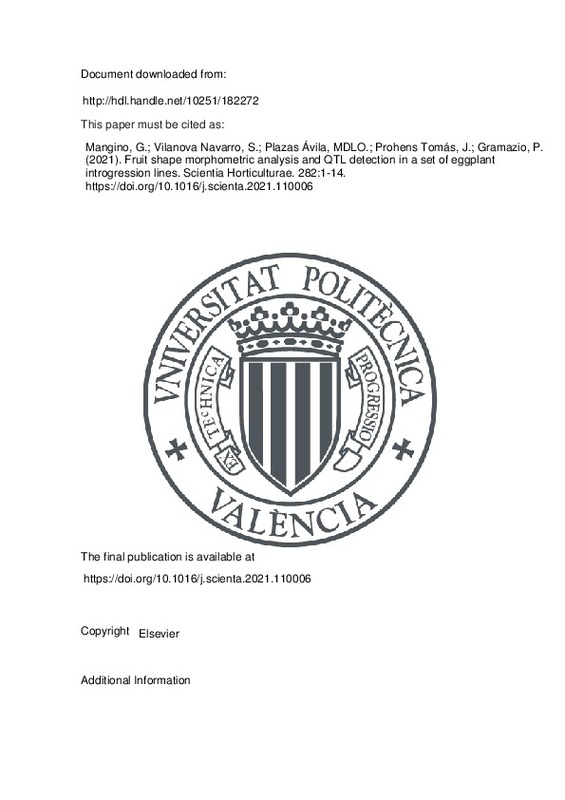Mangino, G.; Vilanova Navarro, S.; Plazas Ávila, MDLO.; Prohens Tomás, J.; Gramazio, P. (2021). Fruit shape morphometric analysis and QTL detection in a set of eggplant introgression lines. Scientia Horticulturae. 282:1-14. https://doi.org/10.1016/j.scienta.2021.110006
Por favor, use este identificador para citar o enlazar este ítem: http://hdl.handle.net/10251/182272
|
Título:
|
Fruit shape morphometric analysis and QTL detection in a set of eggplant introgression lines
|
|
Autor:
|
Mangino, Giulio

 Vilanova Navarro, Santiago
Vilanova Navarro, Santiago

 Plazas Ávila, María de la O
Plazas Ávila, María de la O

 Prohens Tomás, Jaime
Prohens Tomás, Jaime

 Gramazio, Pietro
Gramazio, Pietro
|
|
Entidad UPV:
|
Universitat Politècnica de València. Instituto Universitario Mixto de Biología Molecular y Celular de Plantas - Institut Universitari Mixt de Biologia Molecular i Cel·lular de Plantes
Universitat Politècnica de València. Instituto Universitario de Conservación y Mejora de la Agrodiversidad Valenciana - Institut Universitari de Conservació i Millora de l'Agrodiversitat Valenciana
Universitat Politècnica de València. Departamento de Biotecnología - Departament de Biotecnologia
|
|
Fecha difusión:
|
|
|
Resumen:
|
[EN] Eggplant fruit shape is an important quantitative agronomic trait. The use of introgression lines (ILs) for QTLs identification is a powerful tool for the elucidation of the genetic control of eggplant fruit shape. ...[+]
[EN] Eggplant fruit shape is an important quantitative agronomic trait. The use of introgression lines (ILs) for QTLs identification is a powerful tool for the elucidation of the genetic control of eggplant fruit shape. In the present study, a set of 16 eggplant ILs, each harboring a single marker-defined chromosomal segment from the wild eggplant relative S. incanum in the genetic background of S. melongena, was evaluated for fruit shape in two environments (open field and screenhouse). A detailed phenotyping of the fruits of the two parents, hybrid and ILs was performed using 32 morphological descriptors of the phenomics tool Tomato Analyzer. Several morphological differences were found between parents, and the hybrid displayed negative heterosis for many fruit shape traits, being more similar to the S. incanum parent. Significant differences for most fruit shape descriptors were found between ILs and the recipient parent. For many descriptors, the genotype factor had the highest contribution to the percentage of the sum of squares. Although the contributions of the environment and the G x E interaction were significant for almost all descriptors, their effects on fruit shape were relatively low. Hierarchical clustering revealed nine clusters of highly correlated traits and six ILs groups. A total of 41 stable QTLs spread over ten chromosomes were detected. Of these, twenty QTLs associated to Basic Measurement and Fruit Shape Index descriptors were syntenic to other previously reported in several intraspecific and interspecific eggplant populations, while twenty-one QTLs, including Blockiness, Homogeneity, Asymmetry and Internal Eccentricity, were new. In addition, mutations associated to genes belonging to SUN, OVATE and YABBY families described in tomato were reported in the QTLs genomic regions identified in eggplant. Eleven SUN and YABBY genes were proposed as potential candidate controlling fruit shape variations in eggplant. Our results provide novel and highly relevant insights on the genetics of fruit shape in eggplant and have important implications for eggplant breeding.
[-]
|
|
Palabras clave:
|
Solanum melongena
,
S. incanum
,
Introgression lines
,
Fruit shape
,
Morphometric analysis
,
Tomato analyzer
,
QTLs
|
|
Derechos de uso:
|
Reconocimiento - No comercial - Sin obra derivada (by-nc-nd)
|
|
Fuente:
|
Scientia Horticulturae. (issn:
0304-4238
)
|
|
DOI:
|
10.1016/j.scienta.2021.110006
|
|
Editorial:
|
Elsevier
|
|
Versión del editor:
|
https://doi.org/10.1016/j.scienta.2021.110006
|
|
Código del Proyecto:
|
info:eu-repo/grantAgreement/JSPS//FY2019/
info:eu-repo/grantAgreement/AEI/Plan Estatal de Investigación Científica y Técnica y de Innovación 2017-2020/RTI2018-094592-B-I00/ES/INTROGRESION DE TOLERANCIA A LA SEQUIA PROCEDENTE DE ESPECIES SILVESTRES PARA LA MEJORA GENETICA DE LA BERENJENA/
info:eu-repo/grantAgreement/EC/H2020/677379/EU
info:eu-repo/grantAgreement/JSPS//P19105/
info:eu-repo/grantAgreement/MINECO//AGL2015-64755-R/ES/MEJORA GENETICA DE LA CALIDAD FUNCIONAL Y APARENTE DE LA BERENJENA/
|
|
Agradecimientos:
|
This work was undertaken as part of the initiative "Adapting Agriculture to Climate Change: Collecting, Protecting and Preparing Crop Wild Relatives", which is supported by the Government of Norway. The project is managed ...[+]
This work was undertaken as part of the initiative "Adapting Agriculture to Climate Change: Collecting, Protecting and Preparing Crop Wild Relatives", which is supported by the Government of Norway. The project is managed by the Global Crop Diversity Trust with the Millennium Seed Bank of the Royal Botanic Gardens, Kew and implemented in partnership with national and international gene banks and plant breeding institutes around the world. For further information see the project website: http://www.cwrdiversity.org/.Funding was also received from Spanish Ministerio de Economia, Industria y Competitividadand Fondo Europeo de Desarrollo Regional (grant AGL201564755-R from MINECO/FEDER),Ministerio de Ciencia, Innovacion y Universidades, Agencia Estatal de Investigaci ' onand Fondo Europeo de Desarrollo Regional (grant RTI-2018-094592-B-100from MCIU/AEI/FEDER, UE), and European Union's Horizon 2020 Research and Innovation Programmeunder grant agreement No. 677379 (G2P-SOL project: Linking genetic resources, genomes and phenotypes of Solanaceous crops). Pietro Gramazio is grateful to Japan Society for the Promotion of Science for a post-doctoral grant (P19105,FY2019JSPS Postdoctoral Fellowship for Research in Japan [Standard]).
[-]
|
|
Tipo:
|
Artículo
|







![[Cerrado]](/themes/UPV/images/candado.png)


